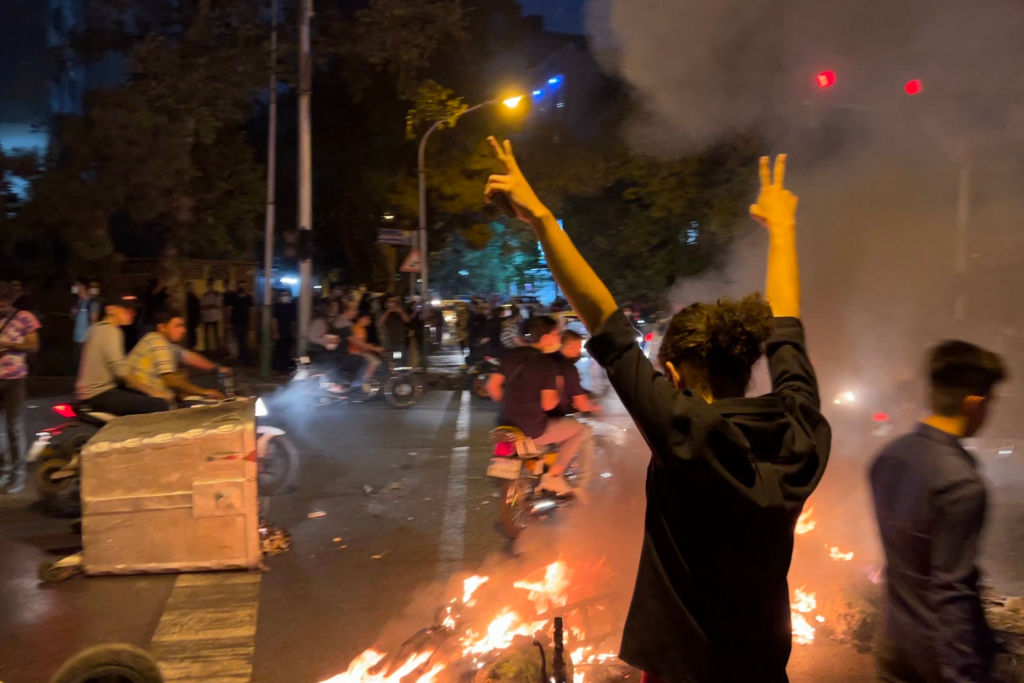
In the aftermath of Mahsa Amini’s death under Iran’s state custody, students have recently given a new energy to the weeks-long protests. They launched large demonstrations at Tehran University on Saturday and Sharif University on Sunday, according to a stream of videos that continue to be released. Protests were also reported at campuses in the central city of Isfahan, Kerman in the south, Mashhad in the northeast, Tabriz in the northwest, and elsewhere.
Experts say the development is significant, and reverses a decade of a politically dormant student movement in Iran.
Since the early days of the Islamic Republic, Iran’s student movements have been a spark for broader protests, says Reza H. Akbari, a Ph.D. candidate of modern Iranian history at American University in Washington, D.C. The most prominent example was perhaps in July 1999, following the government’s decision to close down the reformist newspaper Salam. Students at Tehran University protested the closure, prompting security forces to raid dormitories on campus—leaving at least one student dead and hundreds wounded. The protests soon morphed into a broader movement calling for government accountability. For this reason, “The protests are gaining multiple levels of meaning,” adds Akbari.
Read More: Why Iranian Protesters Chant ‘Woman, Life, Liberty’
Another pivotal moment was back in 1953, when students at Tehran University protested a visit to Iran by then-U.S. Vice President Richard Nixon. Police opened fire on university students, killing three of them. The day of their killing—Dec. 3, 1953—would come to be known as Student Day.
“Universities have been… a place of refuge for political dissent. In Iran, there is no political party, there is no place that you can actually go and be involved in political debates or express your political thoughts. But inside the universities, this suppression has been relatively less successful,” says Nima Tootkaboni, a Ph.D. student in sociology at Johns Hopkins University, who was a student activist in Iran during the 2000s and helped lead an organization called Students for Equality and Freedom.
Iranian authorities came down particularly hard on students at Sharif University on Sunday, according to the New York Times, prompting condemnation from academics around the globe. Protesters were met with rubber bullets, paintballs, and tear gas. It was reportedly some of the most shocking scenes that have come out of Iran, following the 22-year-old Amini’s death on Sept. 16 after Iran’s morality police arrested her for allegedly not following the country’s hijab rules.
“Students are literally flipping the bird at security forces and photos of the clerical establishment, signaling they don’t want to be ruled by an Islamic Republic,” says Holly Dagres, an Iranian-American nonresident senior fellow at the Atlantic Council. “This is evident in the chants they use, their gestures, and their stomping on photos of Supreme Leader Ayatollah Ali Khamenei and Founder Ayatollah Ruhollah Khomeini.”
Students at Sharif University have responded with specific demands tied to the crackdown at their campus last week. They issued a statement calling for the release of all detained students, an official government apology, compensation for damages caused to students, and the closure of disciplinary files for students involved in the protests.
The Islamic Republic has long targeted universities and the ability for students to protest freely. They Islamized the curriculum and banned public gatherings on campus, Akbari says. (While the Iranian constitution allows students to gather peacefully, students, in practice, are often not permitted to do so without restrictions.)
Read more: Why Iran’s Leading Women’s Rights Defender Thinks the Protesters Could Topple the Regime
But the regime has also often tried to placate or win over students, with limited success. In June they tried to garner support through pro-regime music like the song “Hello Commander.” “Even that appears to be a failure as many young Iranians have used its music to create spoof videos and make fun of the song,” Dagres says.
While students added new momentum to the protests, it is female students where the issue of the hijab, which first kickstarted the unrest, is personal—even for those who wear one. “We increasingly see even women from religious backgrounds… speaking out and saying that, ‘the government’s approach is also diminishing and devaluing my freedom of choice to wear the hijab because all of a sudden, I’m no longer someone who’s abiding by my religious beliefs but becoming a symbol of a state and… a political symbol of repression’,” Akbari says.
But Iranians say that Amini’s death has touched off wider criticisms of the Islamic Republic. “It has to do with not having to abide by these compulsions… to veil. There’s a lot of compulsion in Iranian culture and so the demand is freedom,” says Negar Mottahedeh, a professor of literature, media, and feminist Studies at Duke University.
“The current protests… are engaging students… who are ready to live life freely. They’re done with death and grief and mourning,” adds Mottahedeh.
More Must-Reads from TIME
- Donald Trump Is TIME's 2024 Person of the Year
- Why We Chose Trump as Person of the Year
- Is Intermittent Fasting Good or Bad for You?
- The 100 Must-Read Books of 2024
- The 20 Best Christmas TV Episodes
- Column: If Optimism Feels Ridiculous Now, Try Hope
- The Future of Climate Action Is Trade Policy
- Merle Bombardieri Is Helping People Make the Baby Decision
Write to Sanya Mansoor at sanya.mansoor@time.com